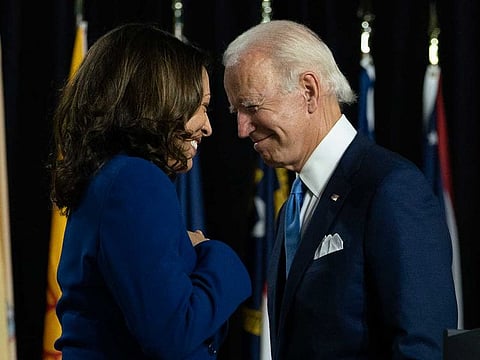Will Kamala Harris bolster Joe Biden post-convention?
Democrats’ choice of running mate could be a defining decision of US election campaign

Also In This Package
The Democrats begin their nomination convention on Monday following Joe Biden’s selection of Senator Kamala Harris as the first bi-racial vice-presidential pick in US history. The decision is widely seen as the ‘safe’ choice for Biden, yet it could still prove to be one of the most consequential choices of running mate in decades.
This is partly because Biden will be the oldest person to assume office in January, at 78, if he triumphs over Donald Trump. With Harris potentially only a ‘heart beat’ from the presidency, she could easily be the next but one holder of the top office in two scenarios. That is, either Biden passes away or is incapacitated in office, or she could well run for the presidency after a Biden term because the vice-presidency has become perhaps the single best transitional office to the Oval Office.
Given this context, Biden searched high and low for the strongest possible pick to provide momentum against Trump in one of the strangest ever election years in US history. Wide-ranging women (Biden said he would not select a man) were considered, of varying ages, ethnicities and experiences, and Harris was right at the top of the pack of those who competed in this year’s Democratic presidential nomination, despite strong support from the liberal wing of the party for Elizabeth Warren from Massachusetts; and centrist Amy Klobuchar from Minnesota.
Other candidates under discussion included several African American politicians: former Georgia gubernatorial candidate Stacey Abrams, Florida congresswomen Val Demings, former Obama administration National Security Adviser Susan Rice, and Atlanta Mayor Keisha Lance Bottoms. Others too included Asian-American US Senator Tammy Duckworth from Illinois, and Latino US Senator Catherine Cortez-Masto from Nevada.
The crucial role of vice-presidents
Aside from the election impact of his decision, another factor he considered in choosing Harris is that the electoral stakes have grown — in the nuclear age — of not selecting a deputy who is perceived to be capable of assuming office effectively upon the incumbent’s unanticipated death or incapacity. This is especially important for Biden given his age.
History underlines the crucial role that vice-presidents stepping up to the presidency have played and it is perhaps Harry Truman who best exemplifies this. Within weeks of assuming office in 1945, after Franklin Roosevelt’s death, Truman had to make several hugely consequential, controversial decisions, including the dropping of atom bombs on Hiroshima and Nagasaki.
Biden hopes to be the third [vice-president to become president] in November, and it is plausible, if so, that Harris could follow becoming the first female president to boot.
In this context, Biden has sought to make a choice that will ‘do no harm’ to his prospects and avoid the mistakes that others have made (Harris as well as serving as a California senator was also formerly the state’s attorney general). Take the example of the 2008 election when Republican nominee John McCain, then aged 71, made the decision to select Sarah Palin — whose only major experience of office was less than two years as Alaska governor. Rather than boosting McCain’s campaign, Palin was — ultimately — widely viewed at the time as too inexperienced to be able to potentially assume the presidency if McCain passed away, or was incapacitated.
Historically, the process of selecting vice-presidential nominees has tended to be fashioned around issues like reconciling important party stakeholders after potentially bruising nomination contests; and the perceived advantage of cultivating ‘balanced tickets’ in which the vice-presidential and presidential candidates where differentiated by factors such as their ‘home’ region of the country so as to maximise support across the nation.
How Harris reinforces Biden's credentials
However, partly because of changes in the presidential nomination system, and indeed the proliferation of mass media, these traditional considerations — while still of consequence — are less relevant to the modern process. For instance, Al Gore was selected in 1992 by Bill Clinton (a fellow centrist Democrat and southerner) not to balance the ticket, but to reinforce the narrative about Clinton’s ‘New Democrat’ change candidacy.
The Californian, bi-racial Harris (the daughter of Jamaican and Indian immigrants) has some ‘balanced ticket’ credentials for Biden (whose home state is Delaware). Yet, she also reinforces his centrist political credentials, just as Gore did with Clinton in 1992.
Biden reportedly wants Harris to have the same sort of close relationship with him as he had with Barack Obama from 2009 to 2017. If so, this would see Harris become a potentially powerful vice-president.
Biden has also deliberately selected a candidate who is a generation younger (Harris is 55) who could well be a future presidential candidate later this decade or even in the 2030s. Since 1960, four sitting vice-presidents (Richard Nixon in 1960, Hubert Humphrey in 1968; Walter Mondale in 1984; and Gore in 2000) won their respective party’s presidential nomination but then lost the general election, whilst two vice-presidents have been elected president (Nixon in 1968 and George H.W. Bush in 1988). Biden hopes to be the third in November, and it is plausible, if so, that Harris could follow becoming the first female president to boot.
Taken together, it is in this context of short-term political calculation and historical precedent that Biden has made what could be a defining decision of the campaign. Especially if Harris hits-the-ground running, the Democratic ticket may secure invaluable new momentum after this week’s convention.
— Andrew Hammond is an Associate at LSE IDEAS at the London School of Economics
Sign up for the Daily Briefing
Get the latest news and updates straight to your inbox









